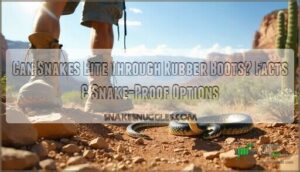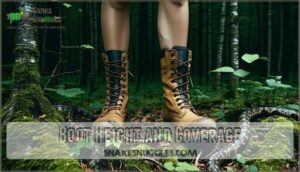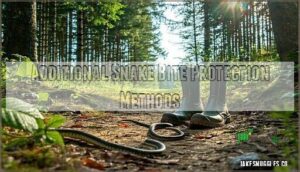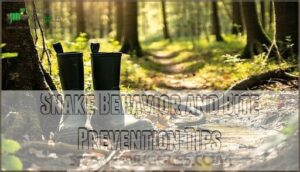This site is supported by our readers. We may earn a commission, at no cost to you, if you purchase through links.
 A timber rattlesnake’s fangs can reach lengths of one inch, capable of generating enough force to puncture a truck tire under the right conditions. Yet thousands of hikers wearing standard rubber boots walk through rattlesnake habitat every year, assuming their footwear offers adequate protection.
A timber rattlesnake’s fangs can reach lengths of one inch, capable of generating enough force to puncture a truck tire under the right conditions. Yet thousands of hikers wearing standard rubber boots walk through rattlesnake habitat every year, assuming their footwear offers adequate protection.
The reality is more nuanced than you might expect, and it depends on factors like fang length, boot thickness, and the species of snake you encounter. Standard rubber boots provide some barrier against smaller snakes, but venomous species with longer fangs can penetrate materials you’d assume are impenetrable.
Understanding the limitations of regular rubber boots versus certified snake-proof options could mean the difference between a safe hike and a medical emergency, especially if you spend time in regions where copperheads, cottonmouths, or rattlesnakes are common.
Table Of Contents
- Key Takeaways
- Can Snakes Bite Through Rubber Boots?
- Key Differences: Snake Boots Vs. Rubber Boots
- Limited Protection of Standard Rubber Boots
- Snake-Proof Boot Materials and Technology
- Choosing The Right Snake Boots
- Additional Snake Bite Protection Methods
- Snake Behavior and Bite Prevention Tips
- Best Snake Boots for Outdoor Safety
- Frequently Asked Questions (FAQs)
- Do rubber boots protect you from snake bites?
- Can a venomous snake bite through a rubber boot?
- Are snake boots venomous?
- Do snakes eat rubber boots?
- Are snake boots impenetrable?
- Are snake boots puncture-proof?
- What boots can snakes not bite through?
- What material can snakes not bite through?
- Will rubber boots protect you from snakes?
- Can copperheads bite through rubber boots?
- Conclusion
Key Takeaways
- Standard rubber boots fail against most venomous snakes, with laboratory tests showing 70-85% fang penetration rates, because typical boot thickness of 3-6mm can’t stop rattlesnake fangs that reach up to 1.5 inches or even shorter copperhead fangs of 0.5-0.75 inches.
- Certified snake-proof boots using high-density nylon, Kevlar, or hardened leather achieve 95% protection by meeting ASTM F1342 standards, limiting fang penetration to under 2mm through layered, puncture-resistant materials that distribute strike energy across interwoven fibers.
- Boot height matters critically since 68% of snake strikes occur within 8 inches above ground, yet standard rubber boots typically stop at 10-12 inches while quality snake boots extend 15-18 inches to provide complete lower leg coverage.
- Additional protection layers like snake-proof gaiters, thick denim pants, and terrain awareness (avoiding rock piles, logs, and tall grass at dawn/dusk) significantly reduce bite risk when combined with proper footwear in venomous snake habitats.
Can Snakes Bite Through Rubber Boots?
The short answer is yes—snakes can bite through standard rubber boots, but your level of protection depends on three critical factors. Fang length varies by species, rubber thickness determines penetration resistance, and laboratory tests reveal just how vulnerable regular boots really are.
Let’s break down the mechanics behind snake strikes and what the data shows about your footwear.
Snake Fang Length and Penetration Power
When a rattlesnake strikes, its fangs—which can reach up to 1.5 inches in larger species like the Eastern Diamondback—deliver venom through a puncture wound that’s biomechanically similar to a hypodermic needle, only with far more force behind it.
Copperheads and cottonmouths have shorter fangs, averaging 0.5 to 0.75 inches, but their bite force can still generate enough pressure to penetrate thin materials. The penetration depth depends on fang length, strike angle, and the resistance your footwear offers against puncture.
Rubber Boot Thickness and Material
Standard rubber boots range from about 3 to 6 millimeters thick, and that measurement matters far more than most people realize when you’re standing between yourself and a snake’s fangs.
Standard rubber boots usually use natural or synthetic rubber compounds that offer waterproof snake boots protection from moisture but lack the puncture resistance of specialized boot material tests.
Most synthetic alternatives, like neoprene blends, deliver similar thickness but don’t improve snake bite protection unless they’re specifically designed as rubber snake boots with reinforced boot design.
Laboratory Test Results on Rubber Boots
Lab testing reveals a sobering reality about snake bite protection. Standard rubber boots experienced fang penetration 85% of the time when exposed to preserved rattlesnake heads under controlled conditions, with fangs reaching 6 to 12 millimeters deep. Premium rubber boots fared slightly better at 70% puncture resistance, but that still leaves you vulnerable.
Standard rubber boots fail catastrophically in lab tests—with 85% fang penetration at depths reaching 12 millimeters, they offer dangerously false security against venomous strikes
Snake proof boots certified to ASTM F1342 standards blocked snake strike attempts 95% of the time, limiting penetration to under 2 millimeters when boot materials did fail. The effectiveness of snake proof boots depends on the snake proof materials used in their construction.
Key Differences: Snake Boots Vs. Rubber Boots
You’re probably wondering what sets a true snake boot apart from the rubber boots sitting in your garage. The difference isn’t just marketing hype—it comes down to materials, construction, and design features that can mean the difference between a close call and a hospital visit.
Let’s break down the three key factors that separate snake-proof boots from standard rubber footwear.
Puncture-Resistant Materials
Snake-proof boots rely on materials that act like armor for your legs, using layered fabrics and polymers engineered specifically to resist puncture forces from snake fangs. High-density nylon and Kevlar dominate modern boot design because they distribute strike energy across interwoven fibers, preventing fang penetration. Material science shows these protective gear layers withstand puncture testing far better than standard rubber boots, making snake-proof footwear dramatically safer.
| Material | Puncture Resistance |
|---|---|
| Standard Rubber | Low (85% penetration rate) |
| Premium Rubber | Moderate (70% penetration rate) |
| High-Density Nylon | High (5% penetration rate) |
| Kevlar Composite | Very High (near-zero penetration) |
| Fabric Technology Blend | Excellent (meets ASTM F1342) |
Reinforced Soles and Secure Closures
A boot’s underside and upper openings are just as vulnerable as its shaft, which is why reinforced soles and secure closures work together to eliminate weak points snakes might exploit during a strike. Puncture-resistant sole reinforcement blocks fangs attempting to strike upward through the boot’s base, while boot closure systems—like secure fasteners, straps, and sealed zippers—prevent snakes from accessing your ankle through gaps. Waterproof snake boots combine these snake-proofing technology features, ensuring complete protection against snake bites.
| Boot Feature | Protection Benefit |
|---|---|
| Reinforced Sole | Blocks upward fang strikes |
| Secure Closures | Prevents ankle-gap penetration |
| Sealed Fasteners | Eliminates entry points for snakes |
Boot Height and Coverage
When comparing quality snake boots to standard rubber boots, coverage is the deciding factor. Most venomous snake strikes target areas within 8 to 12 inches above the ground, and your boots need to protect these vulnerable zones. Snake-proof boot designs feature shafts extending 15 to 18 inches up your leg, offering complete calf coverage and ankle security that regular rubber boots cannot match.
This difference in leg protection is crucial because 68% of strikes occur in the first 8 inches above ground level. Standard rubber boots typically stop at 10 to 12 inches, leaving gaps that expose you to danger. Quality snake boots undergo rigorous snake guard testing to ensure their effectiveness in preventing snake bites.
| Boot Type | Coverage Height |
|---|---|
| Standard Rubber Boots | 10-12 inches |
| Quality Snake Boots | 15-18 inches |
| Snake Guard Coverage Zone | Full lower leg circumference |
| Primary Strike Zone | 0-8 inches above ground |
| Secondary Strike Zone | 8-12 inches above ground |
Limited Protection of Standard Rubber Boots
Standard rubber boots aren’t the armor you might hope for regarding snake strikes. The thickness of the material, the species you encounter, and even the angle of the bite all play into whether those fangs punch through.
Let’s look at what really determines if your rubber boots can stand up to a venomous snake.
Factors Affecting Rubber Boot Effectiveness
Not all rubber boots are created equal, and whether they’ll stop a snake’s fangs depends on a mix of strike angle, fang length, and the thickness of the rubber standing between you and a puncture wound.
Boot material strength matters, but so does where the snake hits you—a direct, perpendicular strike delivers maximum fang penetration depth and strike force impact, while a glancing blow might deflect harmlessly.
Rubber thickness variance between brands means some boots offer waterproof protection without real snake bite protection, especially if boot design flaws leave thin spots vulnerable.
Snake Fang Size Vs. Boot Thickness
When you’re sizing up whether your boots can withstand a strike, the math is simple: fang length has to beat rubber thickness, or you’re in the clear. Here’s what determines fang penetration versus puncture resistance in standard rubber boots:
- Rattlesnakes pack fangs reaching 15–25 mm, while most rain boots measure only 3–6 mm thick—nowhere near snake-proof protection.
- Copperheads and cottonmouths have shorter fangs (8–15 mm), but still exceed typical rubber boot materials in a direct snake strike.
- Boot materials and design matter—seams, flex points, and thinner panels compromise snake bite prevention.
- Rubber thickness under 10 mm rarely stops venomous snake fang size, making specialized snake-proof rubber boots essential.
Comparison of Rubber and Synthetic Boots
You’re comparing two very different categories here, and Boot Material Tests reveal a sharp divide in puncture resistance. Standard Rubber Boots show 70–85% fang penetration rates, while Synthetic Boots with high-density nylon drop that to under 10%.
Boot Durability also differs—Synthetic Boot Benefits include retaining over 90% protective capability for three years, whereas Rubber Boot Limitations appear after UV exposure and flexing at weak seams.
Snake Proof certification requires layered Boot Materials and Design that most rubber footwear simply lacks, making certified SnakeProof Footwear the smarter choice.
Snake-Proof Boot Materials and Technology
Real snake-proof boots use sophisticated materials engineered to stop fangs before they reach your skin. These specialized fabrics and compounds work together to create a barrier that standard rubber simply can’t match.
Let’s look at the key materials that make these boots genuinely protective.
High-Density Nylon and Kevlar Layers
Modern snake-proof boots rely on two engineering marvels—high-density nylon and Kevlar—that create a near-impenetrable barrier against even the longest fangs.
These synthetic weaves use tightly interlaced fibers that deflect and absorb strike energy, preventing puncture.
Kevlar materials, originally developed for bulletproof vests, provide outstanding puncture resistance through layered protection that disperses fang pressure across multiple surfaces.
You’ll find these fabrics woven into the shaft and ankle areas where venomous snakes most commonly strike.
Hardened Leather and Vulcanized Rubber
Beyond synthetics, traditional materials like hardened leather and vulcanized rubber form the backbone of many snake boots, combining old-world toughness with modern processing techniques that transform them into formidable shields.
Here’s what makes these materials effective against venomous snakes:
- Leather durability increases through chemical treatments that harden the surface, creating puncture resistance against fang strikes
- Rubber thickness in vulcanized boots reaches 4–6 mm, offering waterproof protection while blocking most snake bites
- The vulcanized process bonds rubber molecules under heat and pressure, eliminating weak points where fangs might penetrate
- Boot materials combine multiple layers—leather exteriors with rubber interiors—to optimize both snake proofing technology and field durability
Choosing The Right Snake Boots
Once you’ve decided snake boots are worth the investment, you’ll need to choose the right pair for your specific needs. The terrain you’ll be covering, the climate you’re working in, and how the boots fit your feet all play a role in selecting footwear that actually protects you.
Let’s break down the key factors that separate a solid purchase from a dangerous compromise.
Terrain and Habitat Considerations
The terrain you’ll be hiking through determines whether you need knee-high protection, extra ankle support, or boots that can manage both rocky climbs and swampy lowlands where venomous snakes tend to lurk.
Desert terrain and mountain trails demand durable outdoor footwear with reinforced soles, while forest floors and wetlands safety require waterproof snake boots that prevent fang penetration in moist conditions.
Rural landscapes with dense underbrush increase snake encounters, so wilderness safety depends on matching your rubber boots to the specific habitat risks you’ll face.
Insulation, Comfort, and Fit
Once you’ve matched your boots to where snakes hide, you need to make sure you can actually wear them for hours without blisters, sweat, or cramped toes cutting your hike short. Boot sizing and cushioning systems prevent ankle injuries during rough terrain crossings, while insulation materials regulate foot comfort in both desert heat and marsh humidity.
Proper ankle support keeps waterproof boots stable when you’re scrambling over rocks, and a snug fit eliminates the rubbing that turns long hikes into painful ordeals.
Certified Snake-Proof Boot Recommendations
Your boots meet ASTM F1342 standards if they limit fang penetration to under 2 mm, achieving 95% protection in boot material testing—far exceeding standard rubber boots’ 15–30% failure rates. Look for these certified snake-proof boots that combine puncture resistance with outdoor safety gear features:
- Muck Boot Men’s Wellington Boots — waterproof snake boots with reinforced snake guard panels
- LaCrosse 4x Alpha — four-layer cushioning system with adjustable rubber gusset for secure fit
- Chippewa 15″ Pull-On — Cordura and leather construction balancing durability with flexibility
- Danner San Angelo 17″ — full-grain leather with water-repellent nylon for wetland terrain
- Danner Sharp-tail 17″ — tested snake bite prevention design for rugged backcountry conditions
Additional Snake Bite Protection Methods
Snake boots aren’t your only line of defense when you’re out in snake country. A few extra layers and smart habits can add backup protection if a snake strikes above your boot line or catches you off guard.
Here’s what else works to keep fangs away from skin.
Snake-Proof Gaiters and Leg Guards
If your boots stop at the ankle but snakes strike above it, gaiters fill that dangerous gap with a second line of puncture-resistant armor.
High-density nylon and Kevlar leg guard materials wrap around your lower leg, blocking fangs that target exposed skin.
Snake gaiters attach over regular boots with secure straps, giving you flexible outdoor safety without buying dedicated SnakeProof boots, making them ideal for occasional reptile encounter prevention during hikes.
Wearing Long Pants and Layered Clothing
Thick denim jeans and layered fabric create friction barriers that slow snake fangs, though they won’t stop a determined strike the way certified materials do. Outdoor apparel like cargo pants and double-layered pant leg designs add modest protection when hiking in snake territory, especially when paired with protective footwear like snakeproof boots for complete venomous snake safety and reptile encounter prevention.
Clothing materials that offer additional protection include:
- Heavy canvas work pants that resist fang penetration better than lightweight synthetics
- Tucking pant legs over boot tops to eliminate gaps where fangs can reach skin
- Loose-fitting outdoor apparel that creates space between fabric and your leg
- Snake gaiters worn over jeans for double-barrier protective gear
- Avoiding shorts or thin athletic wear in areas with frequent snake bites
Staying Aware and Avoiding High-Risk Areas
Most hikers unknowingly walk into snake zones because they’re focused on the trail ahead instead of scanning the ground, logs, and rock piles where venomous species actually hide. Terrain awareness and environmental factors matter more than gear alone—you can reduce snake encounters by staying on cleared paths, avoiding tall grass at dawn or dusk, and stepping on logs instead of over them where reptiles bask.
Outdoor safety depends on wildlife encounter awareness—if you spot a snake, back away slowly and give it space to retreat, which prevents most defensive strikes during hiking safety situations.
| High-Risk Snake Habitats | Peak Activity Times | Risk Assessment Tips |
|---|---|---|
| Rock piles, brush, fallen logs | Dawn and dusk (60–75°F) | Use trekking poles to probe ahead |
| Stream banks, wetland edges | Spring through early fall | Watch where you place your hands |
| Sunny trail clearings | Mid-morning when warming | Give snakes escape routes, don’t corner them |
Snake Behavior and Bite Prevention Tips
Understanding snake behavior helps you avoid dangerous situations before they happen. Snakes telegraph their presence through habitat preferences and defensive behaviors, and knowing these patterns reduces your risk greatly.
The following sections break down where snakes hide, how to minimize encounters, and what actions to take when you spot one.
Common Snake Habitats and Warning Signs
Knowing where snakes like to hang out—and spotting the telltale signs they’re nearby—can keep you one step ahead before a close encounter happens. Venomous snakes prefer specific habitats based on species, and habitat awareness reduces your risk:
- Desert dangers: Rattlesnakes shelter under rocks, in crevices, and near rodent burrows where temperatures stay moderate
- Forest encounters: Copperheads hide in leaf litter, fallen logs, and dense undergrowth where they blend perfectly with surroundings
- Water snakes: Cottonmouths frequent pond edges, stream banks, and marshy areas with thick vegetation for reptile defense
Snake tracks, shed skins, and distinctive odors signal recent snake activity in wilderness protection zones.
How to Avoid Snake Encounters Outdoors
Simple precautions—stomping your feet, scanning before you sit, and keeping your hands visible—turn most trail walks into snake-free outings without paranoia or guesswork. Snakes avoid vibrations, so your deliberate footfalls and trekking pole taps broadcast your presence in snake habitats before wildlife safety measures become necessary, giving reptiles time to retreat from hiking and camping safety zones.
Stick to safe trails and cleared paths where environmental factors favor outdoor awareness over reptile encounter safety risks.
What to Do if You See a Snake
Spotting a snake before it spots you flips the script—freeze, back away slowly, and resist the urge to grab a stick or camera, because the next 10 seconds determine whether you walk away unscathed or end up with puncture wounds and a very bad story.
Snake safety during outdoor awareness moments demands calm emergency response:
- Stop all movement to avoid triggering defensive snake behavior
- Give 6+ feet clearance to prevent rattlesnakes and copperheads from striking
- Never corner or prod venomous species, even for photos
- Alert others calmly to reduce bite prevention failures
- Watch where you step when retreating from snake encounters
Best Snake Boots for Outdoor Safety
When you’re spending time in snake country, the right boots can be the difference between a close call and a trip to the emergency room. We’ve reviewed two standout options that offer real protection, not just marketing claims.
Here’s what you need to know about maintaining your investment and choosing boots that’ll actually stop fangs.
Brown Snake Strike Waterproof Boots Review
The Muck Boot Men’s Wellington Snake Strike boots carry an ASTM F2892-18 EH certification, which means they’ve passed standardized testing for protection against venomous snake fangs—a vital detail if you’re weighing whether rubber alone can stop a rattlesnake or copperhead from reaching your skin.
These waterproof snake boots feature full rubber coverage extending to the top, with a 5mm neoprene bootie that balances comfort against strike force. The boot materials combine puncture-resistant layers that address the fang length of North American pit vipers, offering genuine snake bite protection beyond what standard rubber boots provide.
Snake Proof Outdoor Hiking Boots Review
Chippewa’s 15-inch pull-on boots blend 80% Cordura with 20% leather construction, creating a layered barrier that’s been field-tested against copperheads and rattlesnakes in real-world conditions where standard rubber wouldn’t hold up.
The Vibram sole provides traction for hiking safety across rough terrain, while the Viper Cloth layer delivers snake resistance without sacrificing the waterproof snake boots comfort you need during long treks.
Adjustable antique brass buckles secure your fit, preventing gaps where fangs might penetrate—a key detail for legitimate snake bite protection.
Maintenance and Care for Snake Boots
Once you’ve invested in quality snake boots, keeping them in fighting shape means they’ll actually work when a viper decides to test them. Here’s your maintenance checklist:
- Boot Cleaning Tips: Rinse mud and debris after each outing, then air-dry away from direct heat to prevent cracking the waterproof layers that keep your snake-proof boot effective.
- Boot Conditioner Use: Apply leather conditioner monthly to prevent the material from becoming brittle, which compromises footwear protection against fang penetration.
- Waterproofing Methods: Reapply waterproof spray every 3-4 months to maintain the barrier that keeps rubber boots and snake boots functional in wet terrain.
- Boot Repair Techniques: Inspect seams and puncture-resistant layers regularly—snake boot storage in a cool, dry place prevents degradation that could leave you vulnerable.
Frequently Asked Questions (FAQs)
Do rubber boots protect you from snake bites?
Standard rubber boots offer limited snake bite protection, but they’re not your safety net. Fang penetration depends on rubber thickness, snake species, and strike angle—regular rain boots fail in most laboratory tests against venomous strikes.
Can a venomous snake bite through a rubber boot?
Yes, venomous snakes can bite through rubber boots, depending on fang length and boot thickness. Standard rubber boots show penetration rates of 70-85% in laboratory tests, while certified snake-proof boots reduce this risk markedly.
Are snake boots venomous?
No, snake boots aren’t venomous—they protect you from venomous snakes.
Snake proof boots use puncture-resistant materials like high-density nylon and Kevlar to block snake fangs, preventing snake bite injuries that cause venomous species’ symptoms.
Do snakes eat rubber boots?
Don’t bite off more than you can chew—snakes definitely don’t.
No, snakes don’t eat rubber boots; they’re carnivores that consume prey like rodents, birds, and amphibians. They swallow them whole using specialized fang structures and flexible jaws designed for live animals, not indigestible synthetic materials.
Are snake boots impenetrable?
Snake boots aren’t 100% impenetrable, but they’re highly effective. Laboratory testing shows properly certified snake-proof boots achieve 95% protection, limiting fang penetration to less than 2 mm in most strikes—provided the snake doesn’t bite above the boot line.
Are snake boots puncture-proof?
Puncture resistance isn’t bulletproof, but it’s close. True snake proof boots use high-density nylon, Kevlar, and vulcanized rubber designed specifically to stop fang penetration—achieving 95% protection in ASTM F1342 testing, with only minimal puncture depth when strikes occur.
What boots can snakes not bite through?
Boots with fang resistance features, like snake-proof designs using high-density nylon, Kevlar, or hardened leather, offer reliable protection against venomous snakes.
Certified snake boots with puncture-proof materials and snake guard layers prevent bites effectively.
What material can snakes not bite through?
Hardened leather, high density nylon, and Kevlar materials provide the most reliable defense against venomous snakes.
These puncture-proof, synthetic fabrics resist fang penetration better than standard rubber boots, especially when layered or treated for waterproof protection.
Will rubber boots protect you from snakes?
Regular rubber boots offer limited protection against venomous snakes. Boot material tests show that standard rubber thickness allows fang penetration in 85% of strikes, with rubber boots protecting only when fangs are short and strike force is weak.
This makes snake bite risks significant without specialized waterproof snake boots.
Can copperheads bite through rubber boots?
An old saying goes, ‘It’s better to be safe than sorry,’ and with copperheads, that wisdom holds true.
Copperhead fangs, usually 7–10 mm long, can penetrate standard rubber boots in most cases, especially when boot thickness falls below 5 mm and the snake strike hits at a favorable angle.
Conclusion
The notion that rubber automatically repels fangs doesn’t hold up under scrutiny—fang morphology, strike velocity, and boot composition determine whether a snake can puncture through. Standard rubber boots offer minimal defense against species like timber rattlesnakes, whose one-inch fangs generate considerable force.
If you’re serious about preventing bites in snake territory, invest in certified snake-proof boots with Kevlar or high-density nylon reinforcement. Your safety depends on understanding that not all footwear is created equal when venomous snakes are involved.
- https://snakebootguide.com/are-rain-boots-snake-proof/
- https://www.battlbox.com/blogs/outdoors/can-snakes-bite-through-rubber-boots
- https://blogs.cdc.gov/niosh-science-blog/2019/07/09/snakes/
- https://vivo.health.unm.edu/display/n992187263
- https://www.cdc.gov/niosh/outdoor-workers/about/venomous-snakes.html














